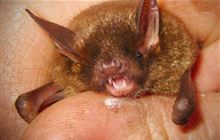Bat monitoring a success in Pureora Forest
Archived content: This media release was accurate on the date of publication.
Introduction
The 2023 round of short-tailed bat/pekapeka monitoring has just been completed in the Pureora Forest.Date: 07 March 2023
Walking into a dark forest full of bats might sound like a spooky movie scene to most people, but it’s an exciting and rewarding field task for DOC staff.
The 2023 round of short-tailed bat/pekapeka monitoring has just been completed in the Pureora Forest, one of New Zealand’s biodiversity hotspots and a key location for the native mammals, which, under the NZ Threat Classification System, are classified as “at risk – declining”. The monitoring information will be used to give an estimate of population survival and gauge the effectiveness of predator control programmes in the area.
Tertia Thurley, a DOC Technical Advisor, says this year’s capturing and tagging of more than 200 bats marked a successful week in a favourable weather window.
The bat monitoring work involved setting up harp traps, which, as their name suggests look like harps with bags beneath them and capture the bats unharmed. The Pureora work involved a team of 27 people, with 18 carrying out the capture and tagging of the animals, and nine others acting as observers.
Bats already tagged were let go, ones that weren’t tagged were put into special bags and taken to a central area where a PIT tag was inserted.
These PIT tags – the same sort of device used to microchip dogs – are used to individually identify bats as they fly in and out of known roosts. The roosts are equipped with aerials which can read the tag number and store this information along with date and time.
“We tagged 219 bats over three nights, surpassing our target of 200, and catching a good mix of juveniles and adults, males and females,” Tertia says.
“During and after the tagging period – between 24 January and 10 February – the bat loggers were operating at roost entrances.
“These loggers detect PIT tagged bats going in or out of the roosts. The information collected includes the PIT tag ID of the bat, the date and time when the bat left/entered the roost.”
Tertia says 788 individual tagged bats were detected, comprising animals tagged in previous years and newly tagged specimens captured during the 2023 work.
“I’m confident there are many more bats out there than the ones we tagged,” says Tertia, pointing to the value of the tags as providing crucial data to understand annual survival rates for the animals.
Pureora-based Biodiversity Ranger Troy McDonald, who contributed to the tagging work, describes the bats as “beautiful, incredibly unique and very feisty”, and the human team as “intelligent, passionate and lovely”.
“This Pureora population of pekapeka may be small in comparison to other Aotearoa populations, but they are unique because it is only here, they have been photographed feeding on and pollinating dactylanthus, a native parasitic plant also known as wood rose,” says Troy.
“I feel very lucky to not only have finally seen these amazing animals up close, but also having handled, processed and released them,” he says.
Background information
Short-tailed bats are threatened by predation from ship rats, stoats, possums, cats - as well as habitat fragmentation and modification. The Pureora population has been supported and protected through consistent predator control in the forest, including treatments with 1080. Population monitoring gives an indication of how effective predator control has been.
Contact
For media enquiries contact:
Email: media@doc.govt.nz


